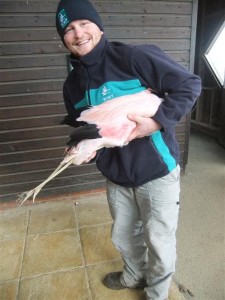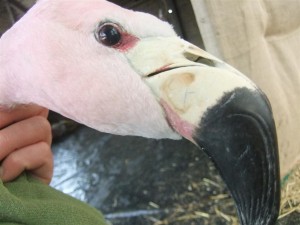The Andean flock returns home!

We recently moved the Andean flamingos back to their traditional haunt after the opening of Flamingo lagoon allowed the flocks to return to the geographical locations around the grounds. This thankfully went without a hitch, to a huge sigh of relief from Avicultural staff... Handling flamingos is always a delicate proceedure. For a species of bird with such long legs, there is remarkably little padding around those leg bones! The difficulty is measured at Slimbridge within the Aviculture department by numbering the potential "nightmare scenarios." These are numerous, and aren't necessarily predictable to the bird handling novice.
First, the legs must always be kept below the horizontal. This is due to the fact that the flamingo circulatory system is heavily dependant on gravity, and being held under the armpit of your average avic was not necessarily counted in their evolutionary design. If held too high, when the bird is released back onto the water in can appear legless as the blood flow is restored. It is during these temporary moments that they can actually accidentally damage themselves. The first rule then is; 1. legs down.
The second rule is the middle finger rule to prevent leg twisting. Jay (below) posed to show his hand just above the ankle in the centre of the legs. He has his middle finger placed between the legs, and the other two wrapped around either side. The key to choosing 'above' the ankle is to allow for "kicking out." Restricting all leg movement is likely to stress the flamingo immeasurably. The key then is to find a way of controlling them without making them feel constricted. As a result, we find controlling the leg above the knee stops them twisting together and causing strains, as well as giving the bird the ability to show its displeasure without ruining the whole proceedings by kicking out with the lower leg. (This being said, they also try to rip your earlobes off, so they do have other avenues to show their displeasure...)
Thirdly, the transport needs to be very well conceived. We use carrying crates of around 4-5ft in height. These have a solid base, and are essentially just a basic wooden frame. Every piece of wood is softened within the kind of foam cladding plumbers use to insulate pipes, and then each compartment is individually separated using a length of taut woven hessian. This soft taut wall material allows their ankle hocks to bounce back from any violent kick or wriggle, and will minimise leg and wing spur bruising. Inside each compartment is a pile of straw for comfort if they fall, although the internal diameter is such that it should only allow them to sit or stand in one direction only rather than twist and turn. We pack them in very gently using two people per bird, one for the body and one for the legs. Unlike other long legged bird crates such as cranes, we do not design the crates so that the birds can walk out under their own steam. Instead we much prefer to give the bird a physical body check before release, and then a soft hand release onto the water. A water release can help guarantee leg safety because if they fall they can float safely until fully mobile.
Lastly it is absolutely vital that you are in the "zone." No chatting or discussion should really take place during a catch unless absolutely vital. The bird does not need the stress. As such we tend to move the flamingos around in relative secrecy. With the Andeans, this was especially poignant. This lovely flock is very well loved due to their levels of bonding and observed contentment. They are one of the few flamingo groups that actually manage to 'move' people emotionally. They display with all guns blazing, and put far more effort into their pink makeup than any of the other older groups. Since their capture these golden oldies have an easy life at WWT Slimbridge, but even now being handled is not high on their list of activities... In their time they have been moved all round the trust, but have shown the highest levels of stress in doing so. As they age, we counter these factors in all the more. With the last Andean hatched in 1997, these birds probably have an average age of over 40! JAZ and JAL in particular are believed to be exceptionally old, showing evidence of rheumatism and arthritis. After a certain age they are also susceptible to stress induced heart conditions. The method then is above all, calm and controlled.



